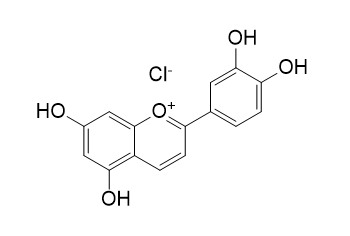Luteolinidin chloride
Luteolinidin chloride (100µM) can significantly blunt the effects of NAD on the cellular responses to GD.
Inquire / Order:
manager@chemfaces.com
Technical Inquiries:
service@chemfaces.com
Tel:
+86-27-84237783
Fax:
+86-27-84254680
Address:
1 Building, No. 83, CheCheng Rd., Wuhan Economic and Technological Development Zone, Wuhan, Hubei 430056, PRC
Providing storage is as stated on the product vial and the vial is kept tightly sealed, the product can be stored for up to
24 months(2-8C).
Wherever possible, you should prepare and use solutions on the same day. However, if you need to make up stock solutions in advance, we recommend that you store the solution as aliquots in tightly sealed vials at -20C. Generally, these will be useable for up to two weeks. Before use, and prior to opening the vial we recommend that you allow your product to equilibrate to room temperature for at least 1 hour.
Need more advice on solubility, usage and handling? Please email to: service@chemfaces.com
The packaging of the product may have turned upside down during transportation, resulting in the natural compounds adhering to the neck or cap of the vial. take the vial out of its packaging and gently shake to let the compounds fall to the bottom of the vial. for liquid products, centrifuge at 200-500 RPM to gather the liquid at the bottom of the vial. try to avoid loss or contamination during handling.
Mol Biol Rep.2024, 51(1):56.
Anal Bioanal Chem.2018, 410(5):1561-1569
Evid Based Complement Alternat Med.2021, 2021:8707280.
BMC Complement Altern Med.2019, 19(1):325
Molecules.2024, 29(5):1171.
Mol Neurobiol.2021, 58(8):3665-3676.
Vietnam Journal of Food Control.2022, 5(3):pp.488-497.
Horticulturae2024, 10(5), 486.
J Sep Sci.2021, 44(22):4064-4081.
Molecules.2020 ,25(16):3697.
Related and Featured Products
Journal of Food Biochemistry, 2010, 32(5):576-596.
Anthocyanin Interactions with DNA: Intercalation, Topoisomerase I Inhibition and Oxidative Reactions.[Pubmed:
19924259]
Anthocyanins and their aglycone anthocyanidins are pigmented flavonoids found in significant amounts in many commonly consumed foods. They exhibit a complex chemistry in aqueous solution, which makes it difficult to study their chemistry under physiological conditions.
METHODS AND RESULTS:
Here we used a gel electrophoresis assay employing supercoiled DNA plasmid to examine the ability of these compounds (1) to intercalate DNA, (2) to inhibit human topoisomerase I through both inhibition of plasmid relaxation activity (catalytic inhibition) and stabilization of the cleavable DNA-topoisomerase complex (poisoning), and (3) to inhibit or enhance oxidative single-strand DNA nicking. We found no evidence of DNA intercalation by anthocyan(id)ins in the physiological pH range for any of the compounds used in this study-cyanidin chloride, cyanidin 3-O-glucoside, cyanidin 3,5-O-diglucoside, malvidin 3-O-glucoside and
Luteolinidin chloride. The anthocyanins inhibited topoisomerase relaxation activity only at high concentrations (> 50 muM) and we could find no evidence of topoisomerase I cleavable complex stabilization by these compounds. However, we observed that all of the anthocyan(id)ins used in this study were capable of inducing significant oxidative DNA strand cleavage (nicking) in the presence of 1 mM DTT (dithiothreitol), while the free radical scavenger, DMSO, at concentrations typically used in similar studies, completely inhibited DNA nicking.
CONCLUSIONS:
Finally, we propose a mechanism to explain the anthocyan(id)in induced oxidative DNA cleavage observed under our experimental conditions.
Synthesis, 2003(12):1878-1880.
A New and Convenient One-StepSynthesis of the Natural 3-Deoxyanthocyanidins Apigeninidinand Luteolinidin Chlorides from 2,4,6-Triacetoxybenzaldehyde.[Reference:
WebLink]
METHODS AND RESULTS:
The total synthesis of apigeninidin chloride (1), Luteolinidin chloride(2) and 5,7-dihydroxyflavylium chloride(5) is performed through a one step reaction from an acetylated derivative of a commercial reagent. Condensation reaction between 2,4,6-triacetoxybenzaldehyde and an acetophenone derivative in anhyd methanolic hydrogen chloride provides the 3-deoxyanthocyanidins in high yields.



